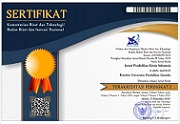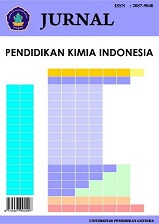A Study of Students' Difficulties and Conceptual Understanding of the Qualitative and Quantitative Analysis of Organic Compound Elements
DOI:
https://doi.org/10.23887/jpki.v8i2.80589Keywords:
Conceptual Understanding, Student's Difficulties, Organic Chemistry, Chemistry Learning, Alternative Learning ModelAbstract
The study examines the learning difficulties and understanding of concepts faced by 28 chemistry students in organic compound element analysis courses using the RADEC learning model. The results showed a moderate increase in understanding. Still, several factors contributed to the low understanding, such as 28% of students reporting difficulty with Kjeldahl material, 24% with Dumas topics, 5% with Lassaigne destruction topics, 9% with Kjeldahl and Dumas topics, and 5% with digestion, distillation, and titration. Additionally, 24% of students did not understand the meaning of the questions, the lecture material's delivery, and the writing of reaction equations. Lack of preparation, such as reading before lectures, also contributed to low understanding.
References
Alao, S., & Guthrie, J. T. (1999). Predicting conceptual understanding with cognitive and motivational variables. Journal of Educational Research, 92(4), 243–254. https://doi.org/10.1080/00220679909597602
Creswell, J. W., & Clark, V. L. P. (2018). Designing and Conductiving Mixed Methods Research (Third). SAGE Publications.
Ebeling, M. E. (1968). The Dumas Method for Nitrogen in Feeds. Journal of AOAC INTERNATIONAL, 51(4), 766–770. https://doi.org/10.1093/jaoac/51.4.766
Fani, T., & Ghaemi, F. (2011). Implications of Vygotsky’s Zone of Proximal Development (ZPD) in Teacher Education: ZPTD and Self-Scaffolding. Procedia - Social and Behavioral Sciences, 29(Iceepsy), 1549–1554. https://doi.org/10.1016/j.sbspro.2011.11.396
Gautam, V. P., Mishra, S., & Ahmed, H. (2023). Comparison of Total Nitrogen estimation by Kjeldahl Method and CHNS Analyzer in Dry Tropical Grassland. International Journal of Plant and Environment, 9(02), 180–182. https://doi.org/10.18811/ijpen.v9i02.13
Gupte, T., Watts, F. M., Schmidt-Mccormack, J. A., Zaimi, I., Gere, A. R., & Shultz, G. V. (2021). Students’ meaningful learning experiences from participating in organic chemistry writing-to-learn activities. Chemistry Education Research and Practice, 22(2), 396–414. https://doi.org/10.1039/d0rp00266f
Hakim, A., Liliasari, Kadarohman, A., & Syah, Y. M. (2016). Effects of the natural product mini project laboratory on the students conceptual understanding. Journal of Turkish Science Education, 13(2), 27–36. https://doi.org/10.12973/tused.10165a
Handayani, H., Sopandi, W., Syaodih, E., Suhendra, I., & Hermita, N. (2019). RADEC: An Alternative Learning of Higher Order Thinking Skills (HOTs) Students of Elementary School on Water Cycle. Journal of Physics: Conference Series, 1351(1). https://doi.org/10.1088/1742-6596/1351/1/012074
Kaçar, S., & Balim, A. G. (2021). Investigating the Effects of Argument-Driven Inquiry Method in Science Course on Secondary School Students’ Levels of Conceptual Understanding. Journal of Turkish Science Education, 18(4), 816–845. https://doi.org/10.36681/tused.2021.105
Lestari, H., Ali, M., Sopandi, W., & Wulan, A. R. (2021). Infusion of Environment Dimension of ESD into Science Learning Through the RADEC Learning Model in Elementary Schools. Jurnal Penelitian Pendidikan IPA, 7(SpecialIssue), 205–212. https://doi.org/10.29303/jppipa.v7ispecialissue.817
Lestari, H., Ali, M., Sopandi, W., Wulan, A. R., & Rahmawati, I. (2022). The Impact of the RADEC Learning Model Oriented ESD on Students’ Sustainability Consciousness in Elementary School. Pegem Egitim ve Ogretim Dergisi, 12(2), 113–122. https://doi.org/10.47750/pegegog.12.02.11
Lestari, H., Setiawan, W., & Siskandar, R. (2020). Science Literacy Ability of Elementary Students Through Nature of Science-based Learning with the Utilization of the Ministry of Education and Culture’s “Learning House.” Jurnal Penelitian Pendidikan IPA, 6(2), 215. https://doi.org/10.29303/jppipa.v6i2.410
Lestari, H., Sopandi, W., Sa’ud, U. S., Musthafa, B., Budimansyah, D., & Sukardi, R. R. (2021). The impact of online mentoring in implementing radec learning to the elementary school teachers’ competence in training students’ critical thinking skills: A case study during covid-19 pandemic. Jurnal Pendidikan IPA Indonesia, 10(3), 346–356. https://doi.org/10.15294/JPII.V10I3.28655
Lopez, E., Kim, J., Nandagopal, K., Cardin, N., Shavelson, R. J., & Penn, J. H. (2011). Validating the use of concept-mapping as a diagnostic assessment tool in organic chemistry: Implications for teaching. Chemistry Education Research and Practice, 12(2), 133–141. https://doi.org/10.1039/c1rp90018h
Mackey, K., McHugh, M., & McGlacken, G. P. (2022). Some people and personalities of organic chemistry: A teaching hook for mid-level university students. Chemistry Teacher International, 4(4), 327–338. https://doi.org/10.1515/cti-2021-0037
McCollum, B., Sepulveda, A., & Moreno, Y. (2016). Representational technologies and learner problem-solving strategies in chemistry. Teaching and Learning Inquiry, 4(2). https://doi.org/10.20343/teachlearninqu.4.2.10
Muñoz, D., Ballesteros, M. M., & Santiago, M. (2018). Validation of the Dumas Method for the Determination of Proteins in Foods. Biosaia, 7(4), 10843.
Nieswandt, M. (2007). Student affect and conceptual understanding in learning chemistry. Journal of Research in Science Teaching, 44(7), 908–937. https://doi.org/10.1002/tea.20169
O’Dwyer, A., & Childs, P. E. (2017). Who says organic chemistry is difficult? Exploring perspectives and perceptions. Eurasia Journal of Mathematics, Science and Technology Education, 13(7), 3599–3620. https://doi.org/10.12973/eurasia.2017.00748a
Pratama, Y. A., Sopandi, W., & Hidayah, Y. (2019). RADEC Learning Model (Read-Answer-Discuss-Explain And Create): The Importance of Building Critical Thinking Skills In Indonesian Context. International Journal for Educational and Vocational Studies, 1(2), 109–115. https://doi.org/10.29103/ijevs.v1i2.1379
Rahmadani, D., Chastanti, I., & Harahap, D. A. (2021). Parents’ Role in Biology Learning During the Covid 19 Pandemic. Jurnal Penelitian Pendidikan IPA, 7(2), 137. https://doi.org/10.29303/jppipa.v7i2.583
Reid, N., & Shah, I. (2007). The role of laboratory work in university chemistry. Chemistry Education Research and Practice, 8(2), 172–185. https://doi.org/10.1039/B5RP90026C
Rosly, N. N., Hamid, S. A., & Rahman, N. A. A. (2021). Exploring the Perception of Chemistry Students at Kulliyyah of Science in Learning Organic Chemistry. IIUM Journal of Educational Studies, 9(2), 6–30. https://doi.org/10.31436/ijes.v9i2.299
Sáez-Plaza, P., Michałowski, T., Navas, M. J., Asuero, A. G., & Wybraniec, S. (2013). An Overview of the Kjeldahl Method of Nitrogen Determination. Part I. Early History, Chemistry of the Procedure, and Titrimetric Finish. Critical Reviews in Analytical Chemistry, 43(4), 178–223. https://doi.org/10.1080/10408347.2012.751786
Sáez-Plaza, P., Navas, M. J., Wybraniec, S., Michałowski, T., & Asuero, A. G. (2013). An Overview of the Kjeldahl Method of Nitrogen Determination. Part II. Sample Preparation, Working Scale, Instrumental Finish, and Quality Control. Critical Reviews in Analytical Chemistry, 43(4), 224–272. https://doi.org/10.1080/10408347.2012.751787
Salame, I. I., Casino, P., & Hodges, N. (2020). Examining Challenges that Students Face in Learning Organic Chemistry Synthesis. International Journal of Chemistry Education Research, 4(April), 1–9. https://doi.org/10.20885/ijcer.vol4.iss1.art1
Salame, I. I., Patel, S., & Suleman, S. (2019). Examining Some of The Students’ Challenges in Learning Organic Chemistry. International Journal of Chemistry Education Research, 3(June), 6–14. https://doi.org/10.20885/ijcer.vol3.iss1.art2
Shea, F., Watts, C. E., Corporation, C. S., & Haute, T. (1933). Dumas Method for Organic Nitrogen Methods of Representing Distribution of Particle Size. Industrial and Engineering Chemistry Analitical, 11(6), 333–334.
Sibomana, A., Karegeya, C., & Sentongo, J. (2021). Students’ conceptual understanding of organic chemistry and classroom implications in the Rwandan perspectives: A literature review. African Journal of Educational Studies in Mathematics and Sciences, 16(2), 13–32. https://doi.org/10.4314/ajesms.v16i2.2
Siregar, L. S., Wahyu, W., & Sopandi, W. (2020). Polymer learning design using Read, Answer, Discuss, Explain and Create (RADEC) model based on Google Classroom to develop student’s mastery of concepts. Journal of Physics: Conference Series, 1469(1). https://doi.org/10.1088/1742-6596/1469/1/012078
Sirhan, G. (2007). Learning Difficulties in Chemistry: An Overview. Journal of Turkish Science Education, 4(2), 2–20.
Sopandi, W. (2017). The quality improvement of learning processes and achievements through the read-answer-discuss-explain-and create learning model implementation. Proceeding 8th Pedagogy International Seminar 2017: Enhancement of Pedagogy in Cultural Diversity Toward Excellence in Education, 8(229), 132–139.
Sopandi, W., & Handayani, H. (2019). The Impact of Workshop on Implementation of Read-Answer-Discuss-Explain-And-Create (RADEC) Learning Model on Pedagogic Competency of Elementary School Teachers. 178(ICoIE 2018), 7–11. https://doi.org/10.2991/icoie-18.2019.3
Sukardi, R. R., Sopandi, W., & Riandi, R. (2021). Repackaging RADEC Learning Model into the Online Mode in Science Class. Journal of Physics: Conference Series, 1806(1). https://doi.org/10.1088/1742-6596/1806/1/012142
Toste, J. R., Didion, L., Peng, P., Filderman, M. J., & McClelland, A. M. (2020). A Meta-Analytic Review of the Relations Between Motivation and Reading Achievement for K–12 Students. Review of Educational Research, 90(3), 420–456. https://doi.org/10.3102/0034654320919352
Vernet, M., Bellocchi, S., Leibnitz, L., Chaix, Y., & Ducrot, S. (2021). Predicting Future Poor Readers from Pre-reading Visual Skills: A Longitudinal Study. Applied Neuropsychology: Child, 0(0), 1–15. https://doi.org/10.1080/21622965.2021.1895790
Zhu, S., Morkan, B., & Yan, Z. (2023). Young geniuses versus old masters: Two different trajectories of individual knowledge bases in the innovation process. Knowledge and Process Management, 30(1), 55–64. https://doi.org/10.1002/kpm.1733
Downloads
Published
How to Cite
Issue
Section
License
Copyright (c) 2024 Fitriah Khoirunnisa, Hendrawan, Asep Kadarohman, Sjaeful Anwar, Amelinda Pratiwi

This work is licensed under a Creative Commons Attribution-ShareAlike 4.0 International License.
Authors who publish with the Jurnal Pendidikan Kimia Indonesia agree to the following terms:
- Authors retain copyright and grant the journal the right of first publication with the work simultaneously licensed under a Creative Commons Attribution License (CC BY-SA 4.0) that allows others to share the work with an acknowledgment of the work's authorship and initial publication in this journal.
- Authors are able to enter into separate, additional contractual arrangements for the non-exclusive distribution of the journal's published version of the work (e.g., post it to an institutional repository or publish it in a book), with an acknowledgment of its initial publication in this journal.
- Authors are permitted and encouraged to post their work online (e.g., in institutional repositories or on their website) prior to and during the submission process, as it can lead to productive exchanges, as well as earlier and greater citation of published work. (See The Effect of Open Access)





